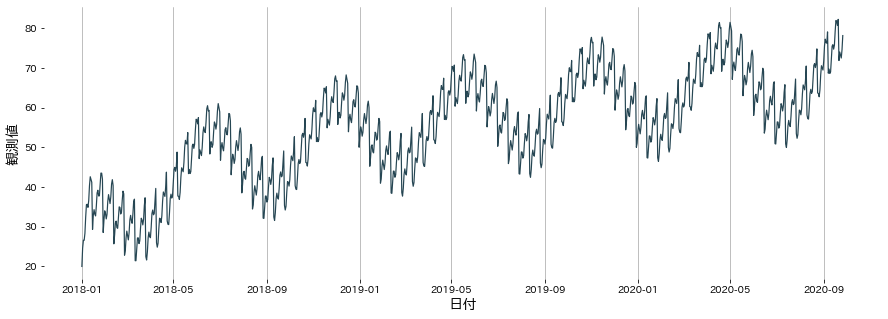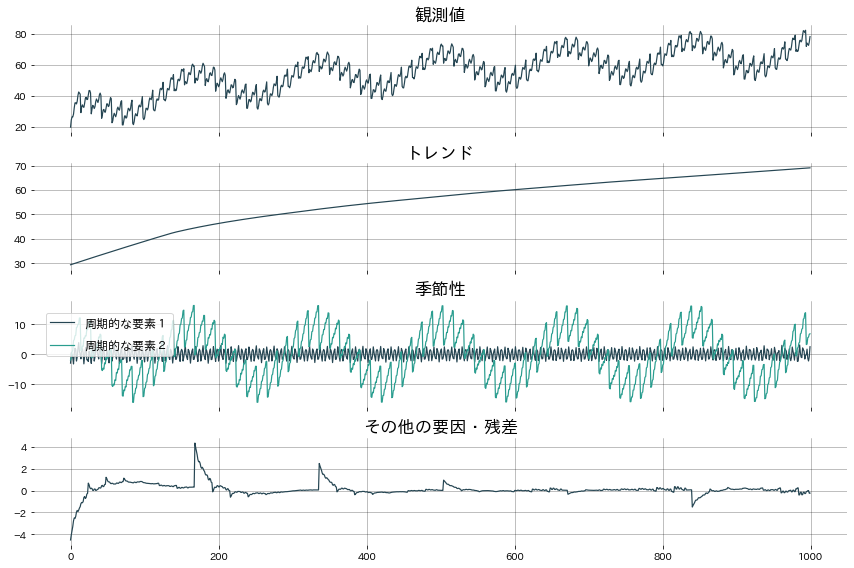MSTL分解
複数の周期性が重なったデータでをトレンド・季節/周期性・残差に分解する
MSTLはSTL分解(LOESSによる季節・トレンド分解)手法を拡張したもので、複数の季節パターンを持つ時系列の分解が可能です。MSTLはstatsmodelの version==0.14.0 以降でのみ使用可能です。詳細はドキュメントをご確認ください。
K. Bandura, R.J. Hyndman, and C. Bergmeir (2021) MSTL: A Seasonal-Trend Decomposition Algorithm for Time Series with Multiple Seasonal Patterns. arXiv preprint arXiv:2107.13462.
Anacondaを仮想環境として使用している場合、conda install -c conda-forge statsmodelsでインストールされるものは0.13.Xとなっています(2022/11/1時点)。その場合、作業中の仮想環境の中で以下のコマンドを使用して最近のバージョンをインストールしてください。
pip install git+https://github.com/statsmodels/statsmodels
import japanize_matplotlib
import pandas as pd
import matplotlib.pyplot as plt
import numpy as np
import seaborn as sns
from statsmodels.tsa.seasonal import MSTL
サンプルデータを作成
周期的な数値を複数組合せ、さらに区分的にトレンドが変化しています。また np.random.rand() でノイズも乗せています。
date_list = pd.date_range("2018-01-01", periods=1000, freq="D")
value_list = [
10
+ i % 14
+ 2 * np.sin(10 * np.pi * i / 24)
+ 5 * np.cos(2 * np.pi * i / (24 * 7)) * 2
+ np.log(i**3 + 1)
+ np.sqrt(i)
for i, di in enumerate(date_list)
]
df = pd.DataFrame(
{
"日付": date_list,
"観測値": value_list,
}
)
df.head(10)
| 日付 | 観測値 | |
|---|---|---|
| 0 | 2018-01-01 | 20.000000 |
| 1 | 2018-01-02 | 24.618006 |
| 2 | 2018-01-03 | 26.583476 |
| 3 | 2018-01-04 | 26.587164 |
| 4 | 2018-01-05 | 28.330645 |
| 5 | 2018-01-06 | 32.415653 |
| 6 | 2018-01-07 | 35.578666 |
| 7 | 2018-01-08 | 35.663289 |
| 8 | 2018-01-09 | 34.892380 |
| 9 | 2018-01-10 | 36.617664 |
plt.figure(figsize=(15, 5))
sns.lineplot(x=df["日付"], y=df["観測値"])
plt.grid(axis="x")
plt.show()

トレンド・季節/周期性・残差に分解する
periods = (24, 24 * 7)
mstl = MSTL(df["観測値"], periods=periods).fit()
- トレンド(.trend)
- 季節/周期性(.seasonal)
- 残差(.resid)
をそれぞれプロットしてみます。今回は二つの周期の異なる三角関数を足しているので .seasonal には二つの列が含まれています。
残差のプロットにところどころ山があるものの、ほとんどの領域で残差が0に近い(=きれいに分解できている)ことが確認できます。
_, axes = plt.subplots(figsize=(12, 8), ncols=1, nrows=4, sharex=True)
axes[0].set_title("観測値")
axes[0].plot(mstl.observed)
axes[0].grid()
axes[1].set_title("トレンド")
axes[1].plot(mstl.trend)
axes[1].grid()
axes[2].set_title("季節性")
axes[2].plot(mstl.seasonal.iloc[:, 0], label="周期的な要素1")
axes[2].plot(mstl.seasonal.iloc[:, 1], label="周期的な要素2")
axes[2].legend()
axes[2].grid()
axes[3].set_title("その他の要因・残差")
axes[3].plot(mstl.resid)
axes[3].grid()
plt.tight_layout()
plt.show()
